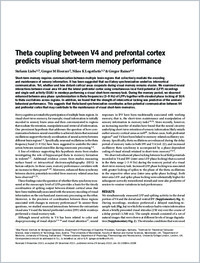Theta coupling between V4 and prefrontal cortex predicts visual short-term memory performance
- Liebe, Stefanie Max Planck Institute for Biological Cybernetics, Department of Physiology of Cognitive Processes, Tuebingen, Germany
- Hoerzer, Gregor M. Institute for Theoretical Computer Science, Graz University of Technology, Graz, Austria
- Logothetis, Nikos K. Max Planck Institute for Biological Cybernetics, Department of Physiology of Cognitive Processes, Tuebingen, Germany
- Rainer, Gregor Department of Medicine, University of Fribourg, Switzerland
-
2012
Published in:
- Nature Neuroscience. - 2012, vol. 15, no. 3, p. 456-464
English
Short-term memory requires communication between multiple brain regions that collectively mediate the encoding and maintenance of sensory information. It has been suggested that oscillatory synchronization underlies intercortical communication. Yet, whether and how distant cortical areas cooperate during visual memory remains elusive. We examined neural interactions between visual area V4 and the lateral prefrontal cortex using simultaneous local field potential (LFP) recordings and single- unit activity (SUA) in monkeys performing a visual short-term memory task. During the memory period, we observed enhanced between-area phase synchronization in theta frequencies (3–9 Hz) of LFPs together with elevated phase locking of SUA to theta oscillations across regions. In addition, we found that the strength of intercortical locking was predictive of the animals’ behavioral performance. This suggests that theta-band synchronization coordinates action potential communication between V4 and prefrontal cortex that may contribute to the maintenance of visual short-term memories.
- Faculty
- Faculté des sciences et de médecine
- Department
- Département de Médecine
- Language
-
- English
- Classification
- Biology, life sciences
- License
-
License undefined
- Identifiers
-
- RERO DOC 28799
- DOI 10.1038/nn.3038
- Persistent URL
- https://folia.unifr.ch/unifr/documents/302334
Statistics
Document views: 160
File downloads:
- Texte intégral: 542
